|
|
Evolution
- Natural selection
- Fitness concept
- Fitness is defined as the ability to pass your genes on, or reproductive success.
- The classical trick question gives you an individual who is strong, healthy, long-living, but does not reproduce. In this case, no matter how good the other traits are, if the individual does not reproduce, then it has a fitness of zero.
- Selection by differential reproduction
- Individuals who reproduce more viable offspring are selected for.
- Individuals who reproduce less viable offspring are selected against.
- Concepts of natural and group selection
- Natural selection = survival and reproduction of the fittest.
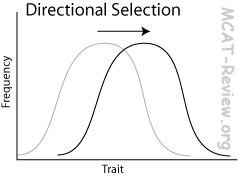
Directional selection: selects for a trait on one extreme. For example, selection for height of canopy trees in a rainforest: trees compete for sunlight, so selection favors trees to become higher and higher.
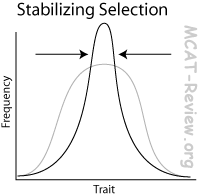
Stabilizing selection: selects for a trait that is moderate, and selects against the extremes. For example, birthweight: too low birthweight means that the baby is premature, too high birthweight means that the mom will have a hard time delivering, so there's a "just right" birthweight that is selected for.
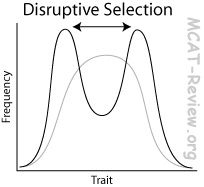
Disruptive selection: selects for the extremes. For example, birds occupying a habitat with 2 distinct niches (eating berries for a living and eating seeds for a living): small beaks are selected for eating berries, large beaks are selected for cracking seeds, medium beak is left out.
- Group selection = natural selection acting on the group, not the individual.
- Explains why altruism exists.
- Altruism sacrifice the fitness of the individual to benefit the group (family), which shares similar genes with the individual. When the benefit outweighs the cost, the altruistic behavior is selected for.
- Evolutionary success as increase in percent representation in the gene pool of the next generation
- If the frequency of an allele increased, then that's evolutionary success for that allele.
- If the frequency of alleles of an individual increased in a population, then that's evolutionary success for that individual.
- Speciation
- Definition of species
- Three conditions for biological species
- Be able to interbreed.
- Be able to produce fertile, viable offspring.
- Does this naturally.
- A dog and a cat can't interbreed, so they don't belong to the same species.
- A horse and a donkey can interbreed, but their offspring, the mule, is sterile. So horses and donkeys aren't the same species.
- Some species of flowers can cross pollinate to produce fertile offspring. However, this never occurs in nature because one is bee-pollinated and the other is bird-pollinated. Thus, they are different species even though they can potentially produce fertile offspring.
- Speciation is the formation of a new species. This can occur due to barriers to successful interbreeding within an initial species.
- Polymorphism
- Polymorphism is just a fancy word for different forms of alleles/traits.
- Adaptation and specialization
- Adaptation is the genetic change in a population caused by natural selection.
- Adaptation is caused by Darwin's natural selection, not by Lamarck's ideas. A giraffe's neck is long because long necks increase the survival rate, so more long-necked giraffes survive to reproduce, and over many generations, the population evolved long necks. The wrong idea by Lamarck is that the giraffe had to reach for higher leaves on trees, so it stretched itself a longer neck.
- Specialization = adaptation of traits to better fill a niche.
- Concepts of ecological niche, competition
- A species' ecological niche is what resources the species uses to survive in its environment.
- Two species can avoid competition, and better use the environment's resources by occupying different niches.
- As long as two species occupy different niches, there's no competition because they use different resources.
- When niches overlap, there's competition.
- Specialization occurs to better occupy a particular niche.
- Concept of population growth through competition
- Population growth is checked by competition.
- When resources get scarce, competition increases, which slows down population growth.
- Competition within a species can force members within the species to occupy different niches, which drives speciation.
- Inbreeding
- Inbreeding is mating between relatives.
- Inbreeding increases the frequency of homozygotes, decreases heterozygotes, and decreases genetic diversity.
- Inbreeding depression occurs because of the increase in the frequency of homozygous recessive detrimental alleles.
- Some species (naked mole rats) naturally inbreed because:
- They stay in one small area and don't migrate much.
- Detrimental homozygous recessive alleles are eliminated because of many generations of natural selection.
- Outbreeding
- Outbreeding is mating with non-relatives, which is just the opposite of inbreeding.
- Outbreeding increases heterozygosity.
- Bottlenecks, genetic drift
- A bottleneck is a severe reduction in population size. This can be caused, for example, by a natural disaster that wipes out a majority of the population.
- Genetic drift is the random changes in allele frequencies.
- The effect of genetic drift increases as population size decreases.
- Bottlenecks increase the effect of genetic drift.
- Divergent, parallel, and convergent evolution
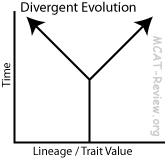
Divergent evolution
- Same lineage, evolving apart to be more different.
- For example, bats and horses. Both share the same lineage as mammals, but the limb of the bat became wings while the horse developed hooves.
- Divergent evolution produces homologous structures (bat's wing and horse's hoof).
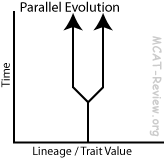
Parallel evolution
- Same lineage, evolving closer together to be similar, using similar mechanisms.
- For example, the feeding structure in different species of crustaceans. The feeding structure came from mutation of pair of legs, turning them into mouth parts. This is a prime example of parallel evolution: same lineage, similar traits, evolved from similar mechanisms/mutations.
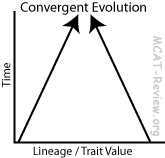
Convergent evolution
- Different lineage, evolving closer together to be similar, using different mechanisms.
- For example, bats and butterflies. Both have wings, but they came from totally different lineages, evolved through different mechanisms/mutations. Convergent evolution produces analogous structures (bat's wing and butterfly's wing).
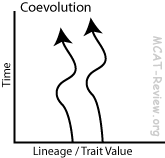
Coevolution
- Two species evolve in response to each other.
- For example, predator/prey or host/parasite species.
- Not yet an official MCAT topic, but many students confuse parallel evolution with coevolution.
- Evolutionary time as measured by gradual random changes in genome
- Random genetic mutations (drift) that are not acted on by natural selection (neutral) occur at a constant rate.
- By measuring the amount of these neutral mutations, you can find out how much time has passed.
- You can compare genome differences between two species to find out how long ago they diverged.
- Another name for this concept is the Molecular Clock.
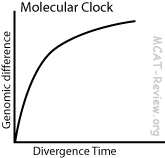
Old topics
Evolution
- Symbiotic relationships (got moved into a different section)
- Parasitism
- Relationship where one benefits (parasite), and the other is harmed (host).
- For example, worms living inside animal intestines.
- Commensalism
- Relationship where one benefits, and the other is not affected.
- For example, some plant seeds disperse by sticking to animal fur.
- Mutualism
- Relationship where both species benefit.
- For example, lichens are made from a mutualistic relationship between fungi and algae. The fungus provides anchor/absorption, and the alga provides photosynthesis.
- Relationship between ontogeny and phylogeny
- Ontogeny = development through the life of an organism.
- Phylogeny = development through evolutionary time of lineages/species.
- In early development, vertebrate embryos share similar features, reminiscent of a common ancestor.
- Gill slits
- Notochord
- Segmentation
- Paddle-like limbs
- Ontogeny recapitulates phylogeny is the idea that the development of an organism repeats the evolutionary history of its species; starting with the fish-like common ancestor, which then changes to the modern form as development continues to adulthood.
- Origin of life
- Organic molecules created by atmospheric gases zapped by lightning, which falls into the ocean to make primordial soup (Oparin and Haldane). Urey-Miller's experiment proved this in a lab.
- RNA World hypothesis: the simple organic molecules formed RNA polymers that can self-replicate (Having enzymatic activity as well as serving as template).
- Protocells: aggregates of RNA, proteins inside lipid envelopes.
- Prokaryotes: first anaerobic heterotrophs because early atmosphere blocks the light required for photosynthesis, then anaerobic autotrophs that undergoes photosynthesis and makes oxygen, then aerobics that utilize oxygen.
- Eukaryotes: evolved by endosymbiosis, where a big cell engulfed a smaller cell and then developed a mutualistic relationship. Heterotrophs engulfed mitochondria. Autotrophs engulfed chloroplasts.
Comparative anatomy
- Chordate = one of the phylums in the kingdom Animalia.
- Chordate features
- Notochord = the "backbone" of the embryo, except that it's not made of bone. In vertebrates, bones will replace the notochord to form the vertebrae.
- Pharyngeal pouches, branchial arches (pharangeal pouches) = gill slits in the embryo. Later develop into various head and neck structures in human.
- Dorsal nerve cord = forms the nervous system. In higher chordates, the nerve cord develops into the brain and spinal cord.
- Vertebrate = a group of chordates (subphylum).
- Vertebrate phylogeny: vertebrate classes and relations to each other
- Fish: In the beginning, there was fish.
- Jawless (Agnatha): The very first fish were jawless, slimy, eel-like.
- Cartilaginous (Condrichthyes/sharks/rays): Then some developed jaws and a skeleton. Condrichthyes has a skeleton made of cartilage.
- Bony (Osteichthyes/food fish): Osteichthyes has a skeleton made of bone.
- Amphibians: the Bony Fish came onto land because their bony skeleton is strong enough to support their weight.
- Reptiles: Can penetrate further onto land because they don't dry out like amphibians do. Similar to amphibians, the reptiles lay eggs.
- Mammals: First to branch off from the reptiles. Unlike the reptiles, mammals have milk glands, hair, and different tooth morphology (heterodontic).
- Birds: next to branch off from the reptiles. Like the reptiles, birds lay eggs. (which came first, the chicken or the egg? Ans: the egg, because the chicken is a bird, and reptiles laid eggs before birds even existed.)
|
|
